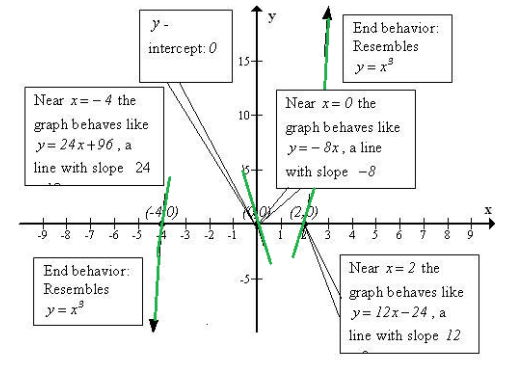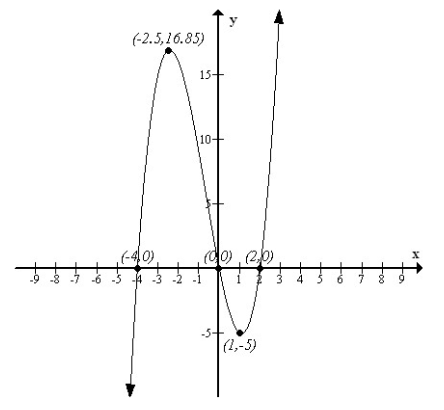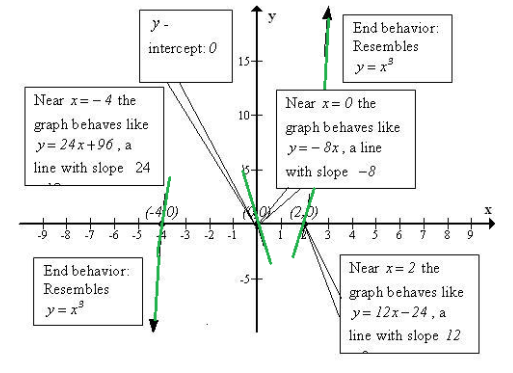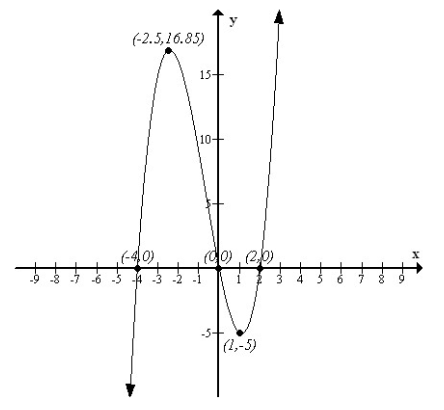
Concept explainers
To analyze: the givenpolynomial function
Answer to Problem 98AYU
Figure 1(a):

Figure 1(b):

Explanation of Solution
Given:
Calculation:
Let us consider the function
This polynomial function
Step1: Determine the end behavior of the graph of the function
Expand the polynomial to write it in the form
The polynomial function f is of degree 3. The graph of f behaves like
Step2: find the x -and y -intercepts of the graph of the function
The y -intercept is
To find the x -intercepts, solve
So,
Step3: Determine the zeros of the function and their multiplicity. Use this information to determine whether the graph crosses or touches the x -axis at each x -intercept.
The zeros or roots of fare -4, 0,2.
The root-4is a zero of multiplicity 1, so the graph off crosses the x -axis at
The root 0 is a zero of multiplicity1. So the graph of f crosses thex -axis at
The root 2 is a zero of multiplicity 1. So the graph of f crosses the x -axis at
Step 4: Determine the maximum number of turning points on the graph of the function.
While the polynomial function is of degree 3 (step1), the graph of the function will have at most
Step5: Determine the behavior of the graph of f near each x -intercept.
Thex -intercepts are - 4,0, and 2.
So, the behavior of the function near -4 is
This is a straight line with a positive slope 24.
Near
This is a straight line with a negative slope -8.
Near
This is a straight line with a positive slope 16.
Step 6: Put all the information from Steps 1 through 5 together to obtain the graph of f Figure 1(a) illustrates the information obtained from Steps 1 through 5. Evaluate f at -2.5, l to help establish the scale on the y -axis. The graph of f is given in Figure 1(b).
Figure 1(a):

Figure 1(b):

Conclusion:
Therefore, the polynomial function
Chapter 4 Solutions
Precalculus
Additional Math Textbook Solutions
Elementary Statistics (13th Edition)
Calculus: Early Transcendentals (2nd Edition)
A Problem Solving Approach To Mathematics For Elementary School Teachers (13th Edition)
Elementary Statistics
Intro Stats, Books a la Carte Edition (5th Edition)
College Algebra with Modeling & Visualization (5th Edition)
- Please focus on ix.arrow_forwardPlease focus on vi.arrow_forward的 v If A is an n x n matrix that is not invertible, then A. rank(A) = n C. det(A) = 0 B. Reduced row-echelon form of A = In D. AB BA= In for some matrix B 63°F Partly sunny Q Search 3 $ 4 40 FS 96 S W E A S T FG S Y & コ B ㅁ F G H J 4 Z X C V B N M 9 H V FIB - FIB ㅁ P L ว DELETE BACHSPACE LOCK L ? PAUSE ALT CTRL ENTER 7 2:20 PM 4/14/2025 HOME J INSERT SHIFT END 5arrow_forward
 Calculus: Early TranscendentalsCalculusISBN:9781285741550Author:James StewartPublisher:Cengage Learning
Calculus: Early TranscendentalsCalculusISBN:9781285741550Author:James StewartPublisher:Cengage Learning Thomas' Calculus (14th Edition)CalculusISBN:9780134438986Author:Joel R. Hass, Christopher E. Heil, Maurice D. WeirPublisher:PEARSON
Thomas' Calculus (14th Edition)CalculusISBN:9780134438986Author:Joel R. Hass, Christopher E. Heil, Maurice D. WeirPublisher:PEARSON Calculus: Early Transcendentals (3rd Edition)CalculusISBN:9780134763644Author:William L. Briggs, Lyle Cochran, Bernard Gillett, Eric SchulzPublisher:PEARSON
Calculus: Early Transcendentals (3rd Edition)CalculusISBN:9780134763644Author:William L. Briggs, Lyle Cochran, Bernard Gillett, Eric SchulzPublisher:PEARSON Calculus: Early TranscendentalsCalculusISBN:9781319050740Author:Jon Rogawski, Colin Adams, Robert FranzosaPublisher:W. H. Freeman
Calculus: Early TranscendentalsCalculusISBN:9781319050740Author:Jon Rogawski, Colin Adams, Robert FranzosaPublisher:W. H. Freeman
 Calculus: Early Transcendental FunctionsCalculusISBN:9781337552516Author:Ron Larson, Bruce H. EdwardsPublisher:Cengage Learning
Calculus: Early Transcendental FunctionsCalculusISBN:9781337552516Author:Ron Larson, Bruce H. EdwardsPublisher:Cengage Learning





